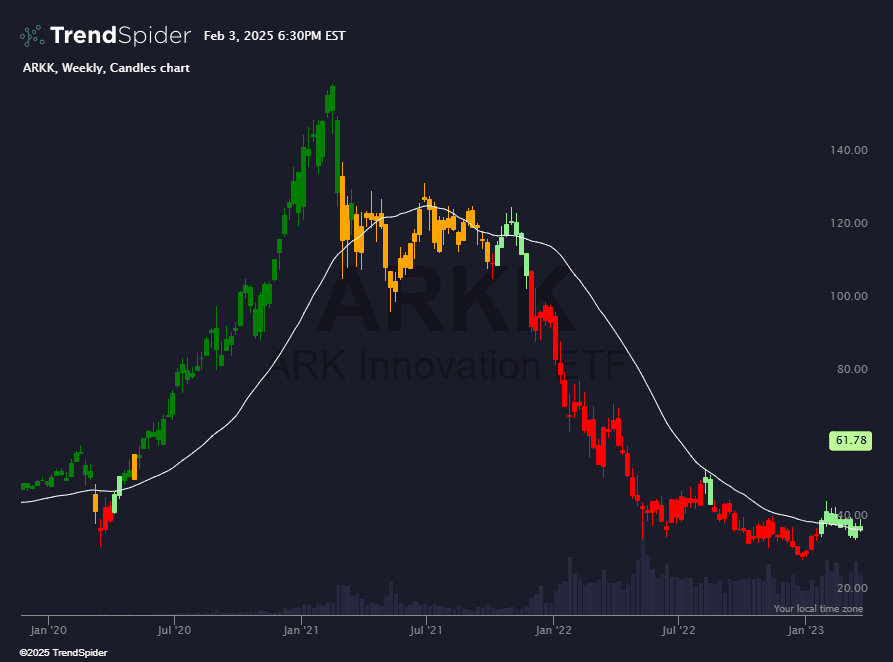Weinstein Stage Analysis

The Weinstein Stage Analysis indicator colors candles based on the four stages of Weinstein Stage Analysis.
Source code
This indicator had been implemented by TrendSpider in JavaScript on TrendSpider. Check out the developer documentation to learn more about JS on TrendSpider.
// This script had been cloned from "Weinstein Stage Analysis" at 27 Jan 2025, 16:14
describe_indicator('Weinstein Stage Analysis');
// This is an experimental implementation of Weinstein Stage Analysis for candle coloring.
// Please note that this is an interpretation and may not perfectly align with all aspects of the analysis.
const smaLength = input.number('MA Length', 30, { min: 1 });
const withinRangePercent = input.number('Within Range %', 5, { min: 0, max: 25 });
// Allow user to select the moving average type
const maType = input.select('MA Type', 'sma', constants.ma_types);
const computeMA = indicators[maType];
// Allow user to adjust candle colors
const stage2Color = input.color('Stage 2 Color', 'green');
const stage3Color = input.color('Stage 3 Color', 'orange');
const stage4Color = input.color('Stage 4 Color', 'red');
const stage1Color = input.color('Stage 1 Color', 'lightgreen');
// Fetch weekly data
const weeklyData = await request.history(current.ticker, 'W');
assert(!weeklyData.error, `Error fetching weekly data: ${weeklyData.error}`);
const weeklyMA = computeMA(weeklyData.close, smaLength);
const withinRange = mult(weeklyMA, withinRangePercent / 100);
let currentTrend = '';
const myColors = for_every(
weeklyData.open, weeklyData.close, shift(weeklyData.open, 1), shift(weeklyData.close, 1), weeklyMA, shift(weeklyMA, 1), withinRange,
(_open, _close, _pOpen, _pClose, _ma, _pMa, _withinRange, _prevColor) => {
const myBodyLow = Math.min(_open, _close);
const myBodyHigh = Math.max(_open, _close);
if (myBodyLow > _ma + _withinRange && _pMa < _ma) {
currentTrend = 'upward';
return stage2Color;
}
if (myBodyHigh < _ma - _withinRange && _pMa > _ma) {
currentTrend = 'downward';
return stage4Color;
}
if (currentTrend == 'upward') {
return stage3Color;
}
if (currentTrend == 'downward') {
return stage1Color;
}
return _prevColor || null;
}
);
// Map weekly colors to the chart's time frame
const myMappedColors = interpolate_sparse_series(land_points_onto_series(weeklyData.time, myColors, time, 'le'), 'constant');
color_candles(myMappedColors);
// Paint the weekly MA for reference
const myMappedMA = land_points_onto_series(weeklyData.time, weeklyMA, time, 'le');
const myInterpolatedMA = interpolate_sparse_series(myMappedMA, 'linear');
paint(myInterpolatedMA, { name: `Weekly ${maType.toUpperCase()}`, color: 'white' });
// Create signals based on candle colors
const myGreenSignal = for_every(myMappedColors, _color => _color === stage2Color ? 1 : 0);
const myOrangeSignal = for_every(myMappedColors, _color => _color === stage3Color ? 1 : 0);
const myRedSignal = for_every(myMappedColors, _color => _color === stage4Color ? 1 : 0);
const myLightGreenSignal = for_every(myMappedColors, _color => _color === stage1Color ? 1 : 0);
register_signal(myGreenSignal, 'Stage 2');
register_signal(myOrangeSignal, 'Stage 3');
register_signal(myRedSignal, 'Stage 4');
register_signal(myLightGreenSignal, 'Stage 1');

